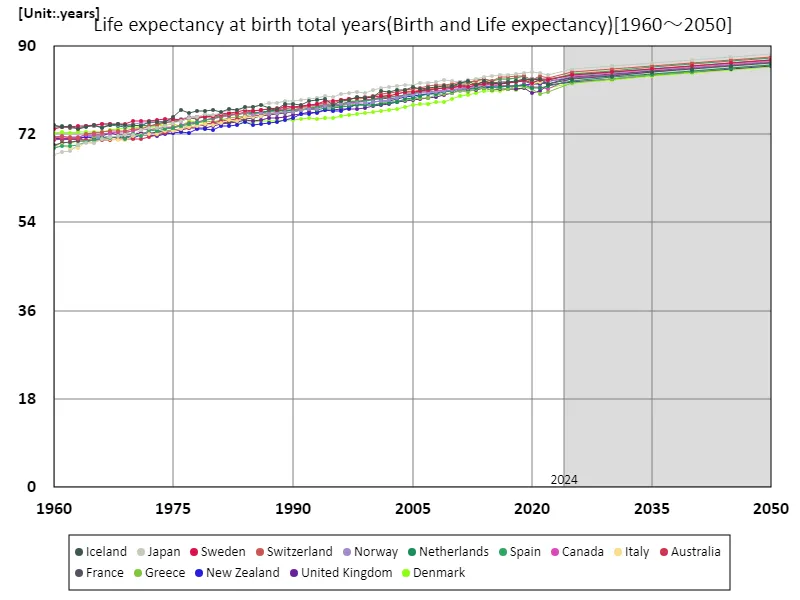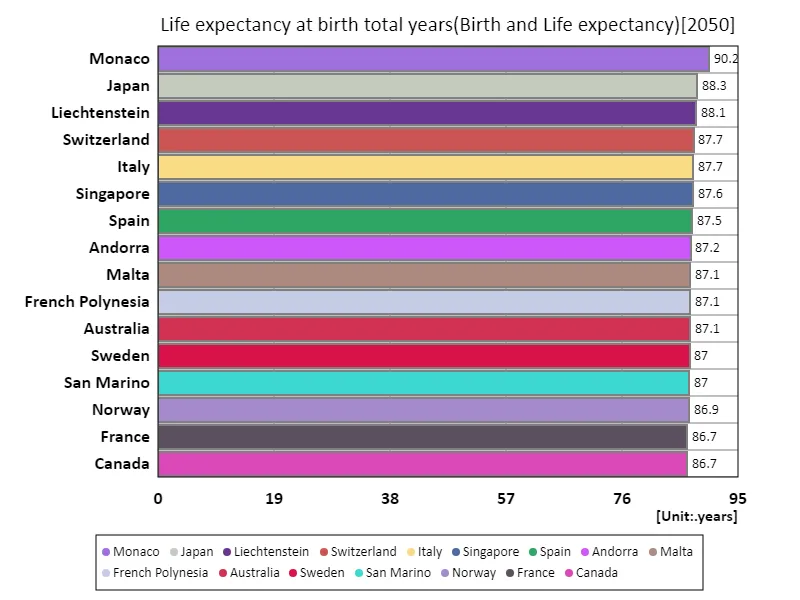Abstract
Life expectancy at birth is an important indicator that reflects a country’s medical care, living environment, economic situation, etc. Japan’s projected average life expectancy in 2050 is 88.3 years, reflecting advances in medical technology, growing health awareness, and improving living standards. Over the past few decades, Japan has become an ageing society with a marked decline in its birth rate. This is resulting in a growing elderly population, which in turn poses new challenges to social security systems and economic growth. This trend is seen in other developed countries as well, but the degree of progress in Japan is particularly striking. Going forward, policies and innovations will be required to address these challenges.
Life expectancy at birth
Looking at life expectancy data at birth from 1960 to 2050, Japan stands out as a poster child for longevity. From the 1950s to the 1960s, advances in medical technology and improvements in living conditions led to a rapid increase in Japan’s average life expectancy. It then continued to grow steadily through the 1990s and 2000s, reaching the highest peak in the world in the 2020s. The average life expectancy is predicted to be 88.3 years in 2050, making Japan the top country in this indicator. The main factors behind Japan’s increased life expectancy include the spread of health care, improved living standards, and improved medical care systems. However, there is also a notable decline in the birth rate and an aging society, and changes in the population structure are becoming an issue. While the current elderly population ratio, at 100% of its peak, is a sign of longer lifespans, it raises concerns about the impact on social security, the labor market, and economic growth. Thus, while a longer lifespan indicates social progress, we are also living in an age where measures to address demographic changes are required. Similar trends are being observed in other developed countries, and global efforts to address these challenges will be important in the future.


The maximum is the latest one, 88.3years of Japan
Life expectancy at birth (worldwide)
Between 1960 and 2050, life expectancy at birth has changed significantly. During this period, Japan stands out as a symbol of longevity. In the 1960s, advances in medical technology and improved living standards led to a rapid increase in life expectancy. The expansion was particularly remarkable from the 1990s to the 2000s, reaching the world’s highest level in the 2020s. It is predicted that Japan’s average life expectancy will reach 88.3 years in 2050. The fact that Japan’s current life expectancy is 100% of its peak is a symbol of longevity, but also suggests a serious aging problem. As the proportion of elderly people increases, the burden of social security and medical expenses increases, and there are concerns about the impact on the economy and labor market. This situation is seen in other developed countries as well, but Japan’s example is particularly striking. In the future, measures will be required to build a sustainable society while maintaining long life spans.


The maximum is the latest one, 88.3years of Japan
Life expectancy at birth (world countries, latest year)
According to data for 2050, Monaco has the highest life expectancy at birth at 90.2 years, compared to the global average of 78 years. This trend reflects advances in medical technology, improvements in living conditions, and growing health awareness over the past few decades. Monaco’s high life expectancy is due to its advanced healthcare system and high standard of living. On the other hand, the average life expectancy of 78 years indicates that medical care and living conditions are continuing to improve in many countries, but there are also large regional differences. The data of 14,600 total lifespans shows the impact of global lifespan extension. Overall, there is a growing trend for life expectancy to continue to increase, which is resulting in an ageing population. As societies age, the burden on medical and social security systems increases, making the creation of sustainable social systems a major challenge for each country. The world as a whole needs to consider economic and social responses while enjoying the benefits of longer lifespans.


The maximum is 90.2years of Monaco, the average is 78years, and the total is 14.5kyears
Life expectancy at birth (region, latest year)
Data for 2050 show that life expectancy at birth will be highest in the euro area at 86.4 years, compared with a global average of 76.6 years. The eurozone’s high life expectancy is largely due to advanced healthcare systems, healthy living environments and economic stability. This reflects the steady increase in life expectancy in the region over the past few decades. However, the global life expectancy of 76.6 years shows regional disparities. In particular, in developing countries, differences in medical care and living conditions have a significant impact on life expectancy, and the extension of average life expectancy tends to be slow. The total life expectancy of 1,150 years indicates that life expectancy continues to increase around the world, and the associated aging of the population is becoming a challenge for each country. In the past, advances in medical technology and improvements in living standards have led to longer lifespans, but in the future, the increasing burden of social security and medical care associated with an aging population will likely become an important issue. Addressing these challenges requires global cooperation and regional responses.


The maximum is 86.4years of Euro area, the average is 76.6years, and the total is 1.15kyears



Comments